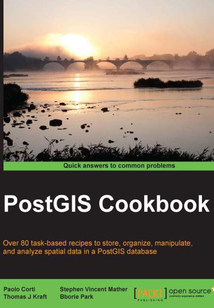舉報 

會員
PostGIS Cookbook
最新章節(jié):
Index
Aneasytouseguide,fullofhandsonrecipesformanipulatingspatialdatainaPostGISdatabase.Eachtopicisexplainedandplacedincontext,andforthemoreinquisitive,therearemoredetailsoftheconceptsused.Ifyouareawebdeveloperorasoftwarearchitect,especiallyinlocationbasedcompanies,andwanttoexpandtherangeoftechniquesyouareusingwithPostGIS,thenthisbookisforyou.YoushouldhavesomepriorexperiencewithPostgreSQLdatabaseandspatialconcepts.
目錄(125章)
倒序
- coverpage
- PostGIS Cookbook
- Credits
- About the Authors
- About the Reviewers
- www.PacktPub.com
- Support files eBooks discount offers and more
- Preface
- What this book covers
- What you need for this book
- Who this book is for
- Conventions
- Reader feedback
- Customer support
- Chapter 1. Moving Data In and Out of PostGIS
- Introduction
- Importing nonspatial tabular data (CSV) using PostGIS functions
- Importing nonspatial tabular data (CSV) using GDAL
- Importing shapefiles with shp2pgsql
- Importing and exporting data with the ogr2ogr GDAL command
- Handling batch importing and exporting of datasets
- Exporting data to the shapefile with the pgsql2shp PostGIS command
- Importing OpenStreetMap data with the osm2pgsql command
- Importing raster data with the raster2pgsql PostGIS command
- Importing multiple rasters at a time
- Exporting rasters with the gdal_translate and gdalwarp GDAL commands
- Chapter 2. Structures that Work
- Introduction
- Using geospatial views
- Using triggers to populate a geometry column
- Structuring spatial data with table inheritance
- Extending inheritance – table partitioning
- Normalizing imports
- Normalizing internal overlays
- Using polygon overlays for proportional census estimates
- Chapter 3. Working with Vector Data – The Basics
- Introduction
- Working with GPS data
- Fixing invalid geometries
- GIS analysis with spatial joins
- Simplifying geometries
- Measuring distances
- Merging polygons using a common attribute
- Computing intersections
- Clipping geometries to deploy data
- Simplifying geometries with PostGIS topology
- Chapter 4. Working with Vector Data – Advanced Recipes
- Introduction
- Improving proximity filtering with KNN
- Improving proximity filtering with KNN – advanced
- Rotating geometries
- Improving ST_Polygonize
- Translating scaling and rotating geometries – advanced
- Generating detailed building footprints from LiDAR
- Using external scripts to embed new functionality in order to calculate a Voronoi diagram
- Using external scripts to embed other libraries in order to calculate a Voronoi diagram – advanced
- Chapter 5. Working with Raster Data
- Introduction
- Getting and loading rasters
- Working with basic raster information and analysis
- Performing simple map-algebra operations
- Combining geometries with rasters for analysis
- Converting between rasters and geometries
- Processing and loading rasters with GDAL VRT
- Warping and resampling rasters
- Performing advanced map-algebra operations
- Executing DEM operations
- Sharing and visualizing rasters through SQL
- Chapter 6. Working with pgRouting
- Introduction
- Startup – Dijkstra routing
- Loading data from OpenStreetMap and finding the shortest path using A*
- Driving distance/service area calculation
- Calculating demographics using driving distance
- Extracting the centerlines of polygons
- Chapter 7. Into the Nth Dimension
- Introduction
- Importing LiDAR data
- Performing 3D queries on a LiDAR point cloud
- Constructing and serving buildings 2.5 D
- Using ST_Extrude to extrude building footprints
- Creating arbitrary 3D objects for PostGIS
- Exporting models as X3D for the Web
- Reconstructing Unmanned Aerial Vehicle (UAV) image footprints with PostGIS 3D
- UAV photogrammetry in PostGIS – point cloud
- UAV photogrammetry in PostGIS – orthorectification
- UAV photogrammetry in PostGIS – DSM creation
- Chapter 8. PostGIS Programming
- Introduction
- Writing PostGIS vector data with Psycopg
- Writing PostGIS vector data with OGR Python bindings
- Writing PostGIS functions with PL/Python
- Geocoding and reverse-geocoding using the GeoNames datasets
- Geocoding using the OSM datasets with trigrams
- Geocoding with geopy and PL/Python
- Importing netCDF datasets with Python and GDAL
- Chapter 9. PostGIS and the Web
- Introduction
- Creating WMS and WFS services with MapServer
- Creating WMS and WFS services with GeoServer
- Creating a WMS Time with MapServer
- Consuming WMS services with OpenLayers
- Consuming WMS services with Leaflet
- Consuming WFS-T services with OpenLayers
- Developing web applications with GeoDjango – part 1
- Developing web applications with GeoDjango – part 2
- Chapter 10. Maintenance Optimization and Performance Tuning
- Introduction
- Organizing the database
- Setting up the correct data privilege mechanism
- Backing up the database
- Using indexes
- Clustering for efficiency
- Optimizing SQL queries
- Migrating a PostGIS database to a different server
- Replicating a PostGIS database with streaming replication
- Chapter 11. Using Desktop Clients
- Introduction
- Adding PostGIS layers – QGIS
- Using the Database Manager plugin – QGIS
- Adding PostGIS layers – OpenJUMP GIS
- Running database queries – OpenJUMP GIS
- Adding PostGIS layers – gvSIG
- Adding PostGIS layers – uDig
- Index 更新時間:2021-07-19 18:30:12
推薦閱讀
- TypeScript Blueprints
- Building a Game with Unity and Blender
- Python網(wǎng)絡(luò)爬蟲從入門到實踐(第2版)
- 精通軟件性能測試與LoadRunner實戰(zhàn)(第2版)
- SSM輕量級框架應(yīng)用實戰(zhàn)
- Learn React with TypeScript 3
- Windows Phone 7.5:Building Location-aware Applications
- 零代碼實戰(zhàn):企業(yè)級應(yīng)用搭建與案例詳解
- Anaconda數(shù)據(jù)科學(xué)實戰(zhàn)
- 深入理解Java虛擬機:JVM高級特性與最佳實踐
- Swift High Performance
- 關(guān)系數(shù)據(jù)庫與SQL Server 2012(第3版)
- 程序員的英語
- ServiceDesk Plus 8.x Essentials
- Vue.js從入門到精通
- 跟著迪哥學(xué)Python數(shù)據(jù)分析與機器學(xué)習(xí)實戰(zhàn)
- 計算機邏輯設(shè)計
- Learning Embedded Android N Programming
- Android for the BeagleBone Black
- Erlang編程指南
- CMake Cookbook
- Drupal 7 Media
- Python網(wǎng)絡(luò)編程(原書第2版)
- Java Data Analysis
- OpenLayers 3.x Cookbook(Second Edition)
- 深入理解Kotlin協(xié)程
- 基于Kotlin的Spring Boot微服務(wù)實戰(zhàn)
- Puppet Reporting and Monitoring
- OpenStack Administration with Ansible
- Reactive Programming with JavaScript

